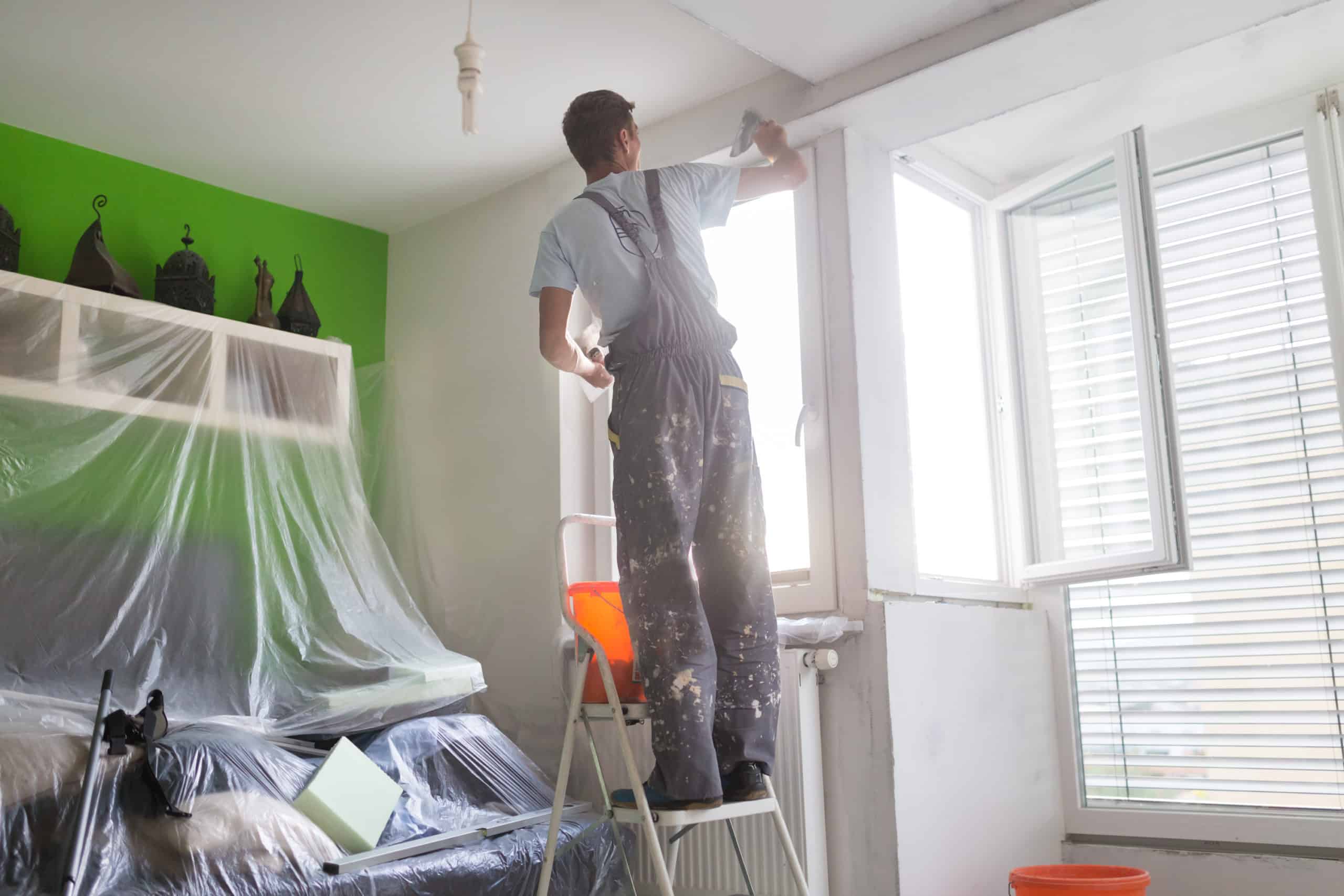Interior painting is a popular DIY project for good reason. A fresh coat of paint can transform the look of a room making it appear brighter, bigger, and cleaner. However, interior painting can be more challenging and time-consuming than it first appears. It’s often one of the most underestimated home improvement projects homeowners undertake.
Follow a Certain Order for Successful Painting

Opinions vary but most agree that a certain order should be followed when painting interior spaces. It takes pre-planning and work to end up with a great paint job. Following these steps can help DIYers work more efficiently and achieve better results.
1. Purchase the Right Amount of Paint
Each gallon of interior paint covers about 400 square feet but coverage can vary depending on the condition and texture of wall surfaces. Making a dramatic change from a dark color to a light neutral usually requires extra coats of paint. It’s best to buy all of the paint needed at one time as there can be slight color differences between paint batches. Online paint calculators are helpful tools for determining the right amount of paint to purchase.
2. Choose the Right Finish
Selecting the right paint finish is important. The finish can dramatically change the look, feel, and durability of paint. The function of the room often dictates the choice of finish. Flat finishes are ideal for ceilings, adult bedrooms, dining rooms, and formal living areas. A satin finish works well in high-traffic areas including hallways, family rooms, and children’s bedrooms. Semi-gloss is a durable finish that is perfect for areas that require frequent cleaning including kitchens and bathrooms.
3. Gather the Necessary Tools and Supplies
Painting an entire room requires numerous tools and supplies to do the job right. Paint, primer, paint rollers, a paint roller extension pole, drop cloths, paintbrushes, a paint tray, sandpaper, painter’s tape, rags, spackle, a putty knife, and a stepladder should all be easily accessible. Rooms with high vaulted ceilings will require extension ladders, scaffolding, and safety equipment.
4. Clear the Space
Painting is always much easier when a room is empty. If the space is large enough, move furniture to the center of the room and cover with old sheets or drop cloths for protection. For smaller spaces, it may be necessary to remove most of the furniture in order to have enough room to work safely and efficiently.
5. Preparation Is Key
Remove light switch and outlet covers, wall fixtures, artwork, and window treatments. Fill in any nail holes or small cracks with spackle and lightly sand. Use a high-quality painter’s tape to protect baseboards and trim. Make sure to thoroughly clean the ceilings, walls, and floors to remove dust, dirt, and grime. Vacuum all surfaces in the room from ceiling to floor before applying primer or paint.
6. Prime Surfaces as Needed
Fresh plaster should be primed and, if changing from a very dark color to a light one, priming will be needed to achieve a professional finish. Apply primer only to clean, dry surfaces. Allow at least two hours for the primer to dry before applying the first coat of paint.
7. Paint the Ceiling First
Ceilings should always be painted first. This allows the ceiling to be painted without worrying about excess paint being sprayed onto the walls by the roller. Paint a 2-inch strip on the ceiling where it meets the wall. Using a roller with an extension pole, start in a corner and work across the short side to maintain a wet edge.
8. Paint the Walls
After the ceiling is complete, the walls should be cut and rolled with at least two coats of high-quality paint. Paint a 2-inch strip along the ceiling, floor, and woodwork with a brush. Using a roller, paint as close to the edges as possible to create a clean, uniform appearance. Most professionals recommend applying paint to walls using a “w” pattern. Make sure the first coat has thoroughly dried before applying a second coat of paint.
9. Paint the Woodwork and Trim
Like any other surface, careful preparation is important when painting trim. For painting baseboards in rooms with wood, tile, or laminate flooring, carefully run painter’s tape along the floor where it meets the trim. Follow with a second strip of tape to make a wider masked area. Use a flat putty knife to tuck ½-inch of 2-inch tape between the baseboard and carpeting. Use drop cloths to protect the flooring along the baseboards.
10. Clean Up
After the last coat of paint is applied and has had a chance to dry, carefully remove all of the painter’s tape. Paint roller covers are inexpensive and hard to clean, so disposing of them is best. Paintbrushes are more costly and worth saving for future projects. For latex and water-based paints, clean brushes with soapy water. Use mineral spirits to clean oil-based paints from paintbrushes. Carefully store leftover paint for future touch-ups or other projects.
Some Painting Projects are Best Left to Professionals
A painting project that might take a professional a few hours to complete may take several days for even the most experienced DIYer. The amount of time a DIY painting project takes will depend on the size of the project, your skill level, and how much preparation is needed. Professional painters have the tools, experience, and techniques to complete interior painting projects quickly and efficiently - often saving busy homeowners both time and money.
Walla Painting is a locally owned business that specializes in residential interior painting. Our fully insured, bonded, and skilled painters are equipped to handle any size project. We are proud to have received Angie’s List Super Service Award 10 years in a row for our customer service and detailed workmanship.
We are here to serve Carmel, Westfield, Zionsville, Noblesville, Fishers, and McCordville homeowners. We offer residential interior and exterior painting, as well as cabinet and trim painting. Contact us online or at (317) 505-0894 for a free estimate.
